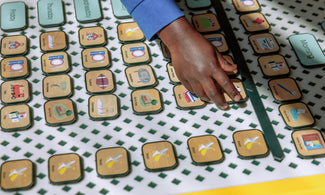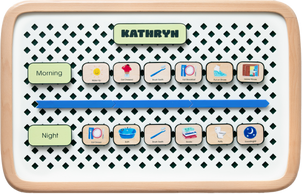Montessori Tips to Encourage Toddler Independence
Here are a few tips to help you embrace your toddlers’ independent nature while keeping them safe and maintaining your daily routine.

"I do it myself!" is a phrase most toddler parents know well. Toddlers are naturally driven to do things for themselves — it’s part of how they learn about the world and build confidence. The Montessori approach offers simple, thoughtful ways to support their independence.
Here are a few tips to help you embrace your toddlers’ independent nature while keeping them safe and maintaining your daily routine.
Simple, Better Toys!
Montessori toys are simple, purposeful toys designed to support a child’s natural development by encouraging hands-on exploration, independence, and focus. When it comes to toys, less is usually more. It might seem counterintuitive but generally, the flashier the toy the quicker a child will lose interest. Play is a child's work and if a toy does the work (like driving when you press a button or making noise when you flip a switch) then a child doesn't have as much opportunity to imagine and learn independently. Montessori toys can be explored, manipulated, and transformed by your child’s imagination, which supports their play and their independence.
Use a Visual Schedule
In a Montessori environment, the goal is to create a clear, predictable structure that empowers children to manage themselves without constant adult intervention. Use a visual schedule, like a Springboard, to help your child understand what is going to happen in their day. Get in the habit of inviting your child to answer questions about the day by looking at their schedule. This empowers them and makes them less dependent on you as the timekeeper. You might say,
You’re wondering what is going to happen after breakfast. Why don’t we take a look at your Springboard and see what comes next.
Over time, children will get in the habit of checking the board, instead of asking you. This shift is incredibly powerful because it offers new visibility into the day and gives children the opportunity to problem solve independently.
Intentional Organization
Environment is a key principle of Montessori education. Organize your family’s toy collection so your child can access their toys independently. The younger the child, the less toys you need to offer at once. Store toys at or below your child’s eye-level, so she can see what materials are available. Place baskets of toys on the floor or display on low shelves, sorted by shape, size, and type of toy.
Let Them Try—Then Try Again
A child’s desire to complete challenging tasks often surpasses his or her physical abilities. Many of us try to embrace our children’s persistence by pausing and letting them “try” to complete these challenging tasks independently. However, the moment they begin to fumble with their zipper or struggle to reach their favorite book on the shelf, we might ask, “Do you want some help?” If so, we’re missing an important step: encouraging them to try again! By asking children, “Do you want to try again?”, we introduce the concept of problem solving and acknowledge that there isn’t always a quick fix. We often need to try again (and try differently!) as we work through a challenge.
Welcome Your Child’s Assistance Around the House
In Montessori education, jobs — or daily responsibilities — are essential because they help children develop independence, responsibility, and a sense of belonging within their home and larger community. When we welcome and acknowledge our children’s assistance, they learn that their actions impact the world around them. Try brainstorming a list of simple, meaningful ways your child can pitch in.
Here are a few of our toddler favorites:
- Sorting socks + matching each sock to a partner
- Using a push cart or doll stroller to “deliver” clean laundry to the appropriate dressers and closets
- Helping to prepare simple meals, like spreading PB & J on bread
- Watering plants, indoors or out!
- Sweeping, vacuuming, and dusting
The takeaway?
Montessori at home doesn’t have to mean overhauling your whole life. It’s about inviting your child into the daily rhythm of your home, giving them tools and trust to explore their world, and stepping back just enough to let them shine.
Because when a toddler says “I do it myself!”, they’re not just being stubborn—they’re practicing for a lifetime of independence.
